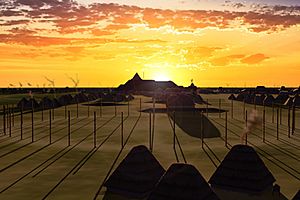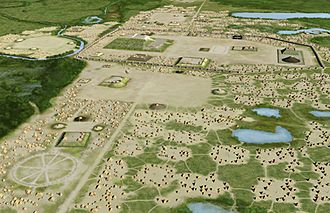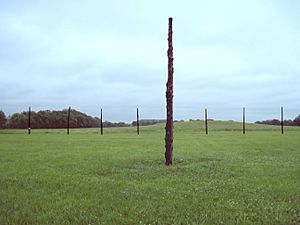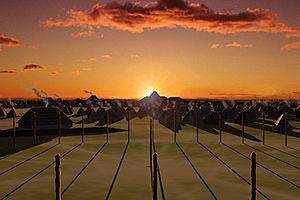Cahokia Woodhenge facts for kids

Artist's conception of Woodhenge III at sunrise circa 1000 CE
|
|
| Location | Collinsville, Illinois, United States |
|---|---|
| Region | Madison County, Illinois |
| Coordinates | 38°39′36.1794″N 90°4′30″W / 38.660049833°N 90.07500°W |
| History | |
| Cultures | Middle Mississippian culture |
| Site notes | |
| Archaeologists | Warren Wittry, Robert L. Hall, William R. Iseminger |
| Architecture | |
| Architectural styles | timber circle |
| Architectural details | Number of monuments: 1 Number of temples: |
The Cahokia Woodhenge was a group of big wooden circles. They were found near Monks Mound at the ancient Cahokia site in Collinsville, Illinois. People from the Mississippian culture built them long ago.
These circles were built between the years 900 and 1100 CE. Each new circle was bigger and had more wooden posts than the one before it. Archaeologists found the site in the 1960s while building a highway. One of the circles was rebuilt in the 1980s.
These circles helped scientists study archaeoastronomy at Cahokia. This is how ancient people understood the sky. Today, special events are held at the site to watch the sunrise during the equinoxes (when day and night are equal) and solstices (longest/shortest days).
Contents
Finding the Woodhenges
How Were They Discovered?
The Cahokia Woodhenges were found by Dr. Warren Wittry in the early 1960s. This happened during "salvage archaeology." This type of archaeology is done when new construction, like a highway, is planned. Archaeologists quickly dig up and save important historical items before they are destroyed.
Most of the area had signs of old village houses. But Dr. Wittry also found some very large, unusual post holes. These holes were about 7 feet (2.1 m) long and 2 feet (0.61 m) wide. They sloped down, showing how tall posts, maybe 20 feet (6.1 m) high, were put into the ground. The posts went about 4 feet (1.2 m) deep.
When Dr. Wittry mapped out the holes, he saw they formed parts of circles. The holes were spaced out evenly. He believed these were full circles and might have been a calendar. They could have been used to track important solar events like the solstices and equinoxes. He called them "woodhenges" because they were like Woodhenge and Stonehenge in England.
More Digs and Discoveries
More digging happened in 1963 with Dr. Robert L. Hall. He used Dr. Wittry's maps to find more post holes. He also found posts near the centers of the circles. These central posts were likely used as observation points.
Dr. Wittry did more excavations in the late 1970s. He confirmed there were five separate timber circles. They are now called Woodhenge I through V. Each circle had a different size and number of posts. Since four of the circles overlapped, experts think they were built one after another. Each new one was usually bigger and had twelve more posts.
Archaeologists found pieces of the original posts in the holes. The wood was red cedar, which was very special to many Native American groups. Red cedar is the only native evergreen tree in the area. It is also strong and resists rot. Traces of red ochre, a red pigment, were also found. This suggests the posts might have been painted.
In 1985, William R. Iseminger led a project to find all the posts for one complete circle. He finished the sequence for Woodhenge III. Then, he led a team to rebuild it. They used red cedar logs for half the posts and black locust wood for the rest. They put the new posts into the original holes.
Today, the Illinois Department of Natural Resources manages the Cahokia site. They host public events to watch the sunrise during the equinoxes and solstices. They do not include ceremonies out of respect for Native American beliefs.
How the Woodhenges Were Built
The people of Cahokia rebuilt these wooden structures many times. This happened over about 300 years while Cahokia was a busy city. Before the woodhenges, people lived in houses in this area. After the last woodhenge was no longer used, people lived there again.
Here are the five different Woodhenges found:
- Woodhenge I: This was the first one, located east of the others. It had 24 posts and was 240 feet (73 m) across. This circle was taken down. Later, a mound called Mound 44 was built partly over this spot.
- Woodhenge II: Built west of the first circle. It had 36 posts and was 408 feet (124 m) across.
- Woodhenge III: This circle had 48 posts and was 410 feet (120 m) across. It was likely built around 1000 CE. This is the version that was rebuilt in 1985. The 48 posts are spaced 7 degrees and 30 minutes apart. The central post is slightly off-center. This helps it line up perfectly with the sunrises at the winter and summer solstices.
- Woodhenge IV: This one had 60 posts and was 476 feet (145 m) across.
- Woodhenge V: Only 13 posts were found for this one. They suggest it might have been 446 feet (136 m) across and could have had 72 posts. Archaeologists think it might not have been a full circle. By this time, it might have been hard to find large trees for the posts near Cahokia.
What Were the Alignments For?
Archaeologists believe the woodhenges were like a giant solar calendar. They helped the people of Cahokia know when the sun would rise and set during the equinoxes and solstices. This was important for farming and religious events.
During the equinoxes, the sun rises exactly east of the timber circle. If you stood in the center of Woodhenge III, the sun would appear to rise right in front of Monks Mound. Monks Mound is about .5 miles (0.80 km) away. The people may have changed the size and location of the woodhenges as Monks Mound grew taller. They wanted to keep this special alignment.
The winter solstice sunrise pole lines up with Fox Mound (Mound 60). This mound is about 1,640 feet (500 m) south of Monks Mound. Fox Mound was about 46 feet (14 m) tall. It likely had a temple on top, making it even taller. From the center of Woodhenge III, the sun would have seemed to rise from this mound during the winter solstice.
Besides tracking the sun, the woodhenges also had religious meaning. You can see their design, a cross in a circle, on special ceramic cups. One cup even has markers for the winter sunrise and sunset positions. It was found near a winter solstice post hole. It also had lines that probably showed the sun's rays.
Since there are many more posts than needed for just sun alignments, some experts think they watched other things. They might have observed the moon's cycles, the Pleiades star cluster, or other stars and planets. Others think the woodhenges helped them plan where to build mounds and pathways.
Images for kids









